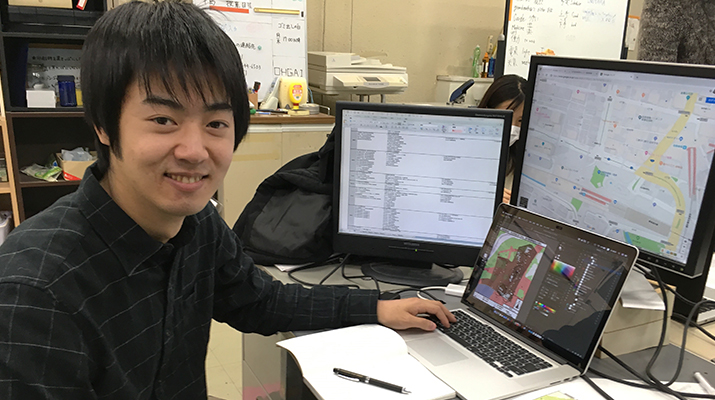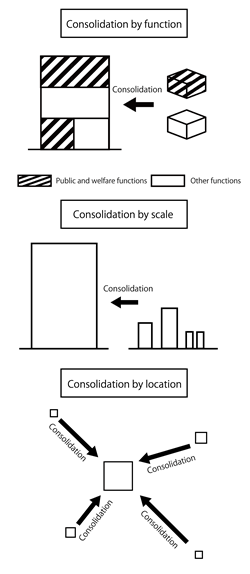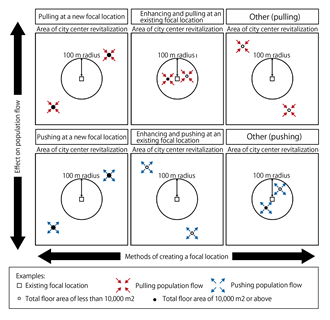
ここからコンテンツです。

Gathering facilities and people
Consolidating public and welfare facilities through government and the private sectorArchitectural Institute of Japan 2017, Outstanding Young Researcher Presentation Award
By Iku Kawano
Iku Kawano, a graduate student at the Department of Architecture and Civil Engineering in Toyohashi University of Technology, shed light on the method of creating focal locations in city centers through the consolidation of public and welfare facilities, by looking at developments currently made in city center areas. There are three different types found in the consolidation of public and welfare facilities: "consolidation by function," which gathers facilities with multiple purposes together; "consolidation by scale," which gathers small scale facilities together; and “consolidation by location," which gathers dispersed facilities together (Fig. 1). Through investigating projects conducted in city centers in terms of the intended usage, total floor area, and distance from major facilities, I found that I could categorize the projects into the following types: those that attempt to create a new focal location at the city center, those that attempt to enhance an existing focal location, and those that have little influence on the existing focal location.
The results of this research were presented at the Architectural Institute of Japan and I was awarded the Outstanding Young Researcher Presentation Award (in the category of urban planning research at academic conferences), which is given to young researchers who delivered an excellent presentation.
Struggles in research
My research focused on analyzing 24 projects across 13 cities involved with the consolidation of public and welfare facilities, and these projects were operated by a variety of organizations, such as local governments, redevelopment unions, and private companies. For this reason, I had to contact the organizations that managed each project, and thus gathering information required a lot of patience. The most difficult experience I faced was when gathering information from redevelopment unions. Once the target project was up and running, the redevelopment unions were dissolved and I had no way of contacting them. As a result, I needed to contact the construction and community-planning companies that were involved in the projects, which required several extra steps.
Details of the research
In this country, where the population is declining and aging, the industrial hollowing-out of city centers is becoming prominent due to various factors, such as the suburbanization of large shops and an increase in motorization. As such, there is a growing importance placed on revitalizing city centers. In response to these circumstances, local governments have been formulating basic plans for revitalizing city centers as an ongoing process since around 2006. It is especially important to improve public and welfare facilities in rural cities with little private investment. Consolidation is significant in that it creates a hub in the city center, which serves to create a center for activity.
In this research, I shed light on the method of creating focal locations at city centers through the consolidation of public and welfare facilities in city centers.
There are many types of projects for consolidating public and welfare facilities. Projects have different influences on the city center based on a combination of different factors including the organization leading the project, the intended usage, the total floor area, and the location. Projects were categorized into three types with regard to the method of creating focal locations at city centers as follows:
- Projects that create a new focal location by building facilities with a total floor area of 10,000m2 or above that are at least 100 meters away from a train station or a city office.
- Projects that enhance the surroundings of an existing focal location by building facilities with a total floor area of less than 10,000m2 that are less than 100 meters away from a train station or a city office.
- Projects that build facilities with a total floor area of less than 10,000m2 at least 100 meters away from a train station or a city office, but that do not create a new focal location nor enhance an existing focal location.
Furthermore, these projects were also divided into two types based on the effect on population flow as well as their main purposes: projects with welfare and commercial purposes that pull population flow towards them, and projects with residential purposes that push population flow away from them. By looking at the data with the methods of creating a focal location on one axis and the effect on population flow on a second axis, I found that there were six methods of creating focal locations as follows and shown in Fig. 2.
- Pulling at a new focal location.
- Pushing at a new focal location.
- Enhancing and pulling at an existing focal location.
- Enhancing and pushing at an existing focal location.
- Other (pulling).
- Other (pushing).
Prospects
Currently there are many public and welfare facilities that are deteriorating and require renewal in municipalities across Japan. However, renovations require significant costs. Thus, consolidation of public and welfare facilities is needed through greater collaboration between government and the private sector. In order to gather population towards a city center, services that are closely related to our everyday life, such as medical services, welfare services, and childcare, become vital. Therefore, it is also important to combine uses when consolidating facilities.
施設を集め、人を集める
行政と民間による公共公益施設の集約化日本建築学会 若手優秀発表賞 (学術講演会・都市計画部門) 2017年9月
By 河野 壱玖
豊橋技術科学大学、建築・都市システム学大学院学生の河野壱玖は、中心市街地整備の現況を見ることで、中心市街地における公共公益施設の集約化による拠点形成手法を明らかにしました。公共公益施設の集約化は、複数の用途を集める「機能による集約」、小規模施設を集める「規模による集約」、分散した施設の立地を集める「立地による集約」の3パターンが挙げられます(Fig.1)。中心市街地内で実施されている事業を、内包用途、延べ床面積、主要施設の距離からみると、中心市街地内で新たに拠点形成を図る事業や既存の拠点の強化を図る事業、拠点への影響が少ない事業があることがわかりました。
本研究の成果を2017年9月に日本建築学会において発表し、若手優秀発表賞 (学術講演会・都市計画部門)を受賞しました。これは、優秀な発表をした若手研究者に贈られるものです。
研究の苦労話
公共公益施設の集約化を図っている13市24事業に着目して分析を行いましたが、事業主体は自治体や再開発組合、民間企業等、様々ありました。資料収集する際には、各事業主体へ問い合わせが必要であり、資料収集には根気が必要でした。その中でも、一番苦労したのは再開発事業を行う再開発組合に資料収集をした時です。対象とする事業が実施され、しばらく時間が経っている場合は、再開発組合が解散し、問い合わせをすることができません。その際には、事業を行った施工会社やまちづくり会社に問い合わせる必要があり、いくつかのプロセスを踏む必要がありました。
研究内容の詳細
人口減少や高齢化が進んでいる我が国において、大型店舗の郊外立地やモータリゼーションの進行等の様々な要因から中心市街地の空洞化が進み、中心市街地の活性化が重要になってきています。その中で、平成18年から各自治体において中心市街地活性化基本計画を策定できるようになり、中心市街地の活性化が進められてきています。特に、民間投資が少ない地方都市では、公共公益施設の整備は重要となります。また、同時に集約化するということは中心市街地内に核をつくるということであり、賑わいの中心を生むことにつながります。
そこで、本研究では、中心市街地における公共公益施設の集約化による拠点形成手法を明らかにしました。
公共公益施設の集約化を行う事業には、様々な種類があります。事業により事業主体や内包用途、延べ床面積、立地等様々であり、これらの組み合わせにより、中心市街地に与える影響は異なります。拠点形成の方法としては、鉄道駅や市役所から100m以上離れた位置で延べ床面積10,000m2以上の施設を整備することにより新たに拠点を形成する事業、鉄道駅や市役所から100m未満の位置で延べ床面積10,000m2未満の施設を整備することにより既存の拠点周辺を強化する事業、鉄道駅や市役所から100m以上離れた位置に延べ床面積10,000m2未満の施設を整備しているが拠点の形成・強化ともに図られていない事業に分類できました。
さらにこれらの事業は、人流への効果として、主要用途から公共公益・商業用途によって人口を吸引する事業と、居住用途によって人口を放出する事業に分けることができました。このようなことから拠点形成の方法と人流への効果の二軸から見ると、拠点形成手法には、新規拠点形成吸引型、新規拠点形成放出型、既存拠点強化吸引型、既存拠点強化放出型、その他(吸引型)、その他(放出型)の6つがあることがわかりました(Fig. 2)。
今後の展望
現在全国の市町村には、老朽化が進み更新が必要な公共公益施設が多く存在しています。しかし、新たに整備するには多くの費用が必要です。そのため、今後はこれまでより行政と民間が連携し、公共公益施設を集約することが必要になってきます。また、中心市街地に人を集めるには、医療や福祉、子育て等の生活に密着した用途も重要となるため、集約する用途の組み合わせも重要になっていくと考えられます。
Student Profile

| Name | Iku Kawano |
|---|---|
| Affiliation | Department of Architecture and Civil Engineering |
| Title | Master course student (2nd grade) |
| Fields of Research | Urban planning/ Urban shrinkage |
ここでコンテンツ終わりです。


